A Fed rate hike coupled with weaker-than-expected employment would not be leading indicators for a rise in equity prices. But in fact, equity prices did rise this week. Perhaps, equity investors were pleased to see a drop in crude oil prices. In fact, crude oil futures were actually below $60 per barrel for three days this past week. As it turns out, each of the day's increase in stock prices can be attributed to a variety of factors including merger activity and strong earnings. Despite the week's gains, the Dow Jones industrials and the Nasdaq composite still are below year-end (2004) levels. The Russell, S&P 500 and Wilshire 5000 are just barely ahead of year-end levels.
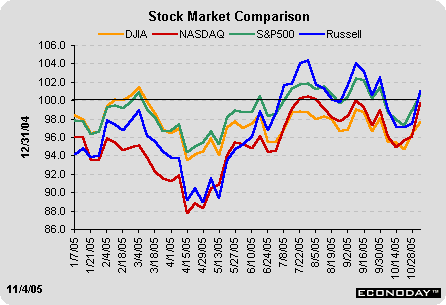
BONDS
Treasury yields have generally been on the rise over the past several weeks - and this week, which included a Fed rate hike, was no exception. To no one's surprise, the Fed announced a unanimous agreement to raise the federal funds rate target by 25 basis points to 4 percent. The post-meeting statement kept most of the same verbiage as previous meetings. For the most part, bond investors and economists are still expecting the Fed to raise the funds rate target by 25 basis points at their December and January 2006 meetings. The January meeting will be Greenspan's final one after 18 years at the Fed. Whether or not new chairman (pending confirmation) Ben Bernanke begins his term with a rate hike on March 28, 2006 will depend on economic conditions at that time. While Wall Street economists and bond investors must predict economic conditions and future rate hikes, the Fed has the luxury of determining its policy at each meeting without predicting in advance what it will do.
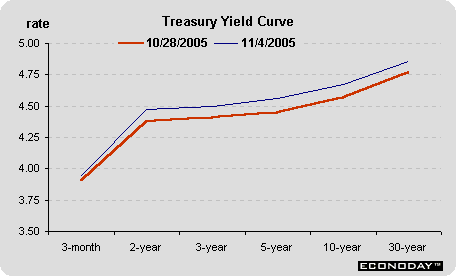
Markets at a Glance

Weekly percent change column reflects percent changes for all components except interest rates. Interest rate changes are reflected in simple differences.
The Economy
NONFARM PAYROLLS UP MARGINALLY IN OCTOBER
Nonfarm payrolls increased 56,000 in October, well below the market consensus. September payrolls were revised up to show a smaller decline (8,000 vs. 35,000) but August payrolls were revised down significantly. On the whole, the August-to-October period shows less employment growth than initially thought. While the September payroll loss was directly attributable to Hurricane Katrina, the Bureau of Labor Statistics believes the weakness in October payrolls came from the rest of the economy (outside the hurricane-ravaged area) based on questions that were asked at survey time and how the employment statistics were assembled. These payroll figures are in direct contrast to other economic data that have shown more momentum going into the hurricane. And it suggests that even though gasoline pump prices may be moderating these days, economic conditions may be less uniformly favorable across the country and across various industries. But even though payroll gains were less than stellar in both September and October, the average workweek increased to 33.8 during those two months after holding at 33.7 in nine of the previous ten months. Sometimes employers will increase the number of hours worked before they hire new workers.
Oddly enough, manufacturing payrolls increased 12,000 in October after declining steadily in the previous four months. The majority of the payroll gain was concentrated in durable goods manufacturing. Factory jobs historically have paid well - and gaining jobs in this sector bodes well for the economy.
Service-producing job gains were miserable. Financial activities was the sector with the largest monthly gain in payrolls. And indeed, this sector has provided a steady flow of job gains in the previous several months as well. Wages & salaries in the financial industry are mixed since some jobs are primarily clerical and others involve higher education levels. It is difficult to tell offhand which types of jobs were created - high or low paying. This has implications for the economy, of course, since high paying jobs allow greater discretionary spending. On average, though, hourly earnings in this industry are higher than factory earnings. Temporary help services did add to payrolls in October, but not as much as the previous month.
The largest declines in the service-producing sector came from leisure & hospitality jobs and information services (primarily motion picture and sound recording industries). That would make the information payroll jobs quite similar to leisure & hospitality - the entertainment segment of the economy. BLS officials suggested that high gasoline prices might have played a role in holding down job growth in the leisure & hospitality sector.
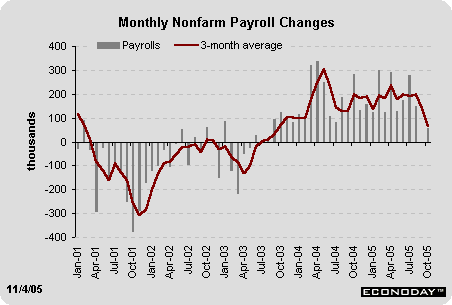
The other labor market survey, the household survey that generates the unemployment rate and the employment-to-population ratio, revealed better news. The jobless rate dipped 0.1 percent to 5 percent and the employment-to-population ratio inched back up to 62.9. While this ratio is still low relative to where it stood the last time the unemployment rate was at 5 percent, it is on the mend.
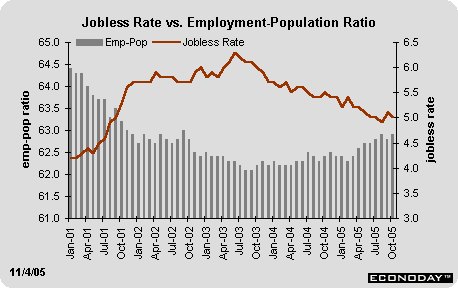
Pundits in the bond market focused on the inflationary aspects of a 0.5 percent increase in average hourly earnings. Keep in mind that this 0.5 percent hike followed increases of 0.1 and 0.2 percent in the two previous months. And while this indicator can sometimes help reveal inflationary wage pressures, it isn't the most ideal indicator of reflecting true increases in wage costs since the mix of employment growth for the month helps determine the average hourly earnings figures. Since employment growth was focused in high paying industries this month, and declines in payrolls were focused in low paying industries, average hourly earnings figure were skewed higher. Granted, the overall trend in year-over-year growth in average hourly earnings has indeed picked up since 2004 (about the time that crude oil prices started to accelerate), but at just under 3 percent in October, this is still less than the inflation rate (measured by the CPI and including both food and energy which, like it or not, consumers can't exclude from their budget.)
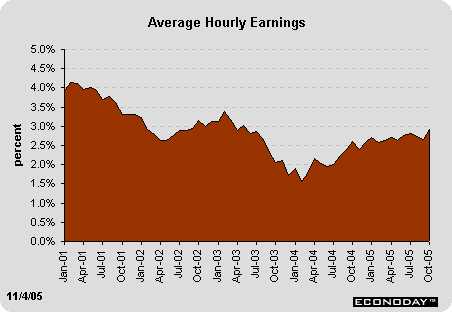
On the whole, the employment situation was not as strong as many economists had expected (though it didn't surprise us since we have been more concerned about high oil prices impacting consumers since the hurricanes.) The anemic payroll growth will hamper personal income growth, but at least some benefits will come from the higher hourly earnings and the steady workweek. Industrial production growth should be more vigorous than in the two previous months judging by the improvement in factory payrolls as well as a 1 percent increase in the factory workweek. Indeed, at 41 hours, October's preliminary estimate for the factory workweek stood at its highest level since May 2004.
Q3 PRODUCTIVITY ACCELERATES
Nonfarm business productivity grew at a 4.1 percent rate in the third quarter, just about twice as fast as the second quarter pace, and posted the largest gain since the second quarter of 2004 when it grew at a 4.5 percent rate. At the same time, unit labor costs declined at a 0.5 percent rate. This was also the best showing since 2004's second quarter.
Productivity growth is a mixed blessing. Higher productivity is supposed to allow workers to get higher wages without generating inflationary pressures. However, faster productivity growth also alleviates the need to increase employment in the short term. (In the long term, everyone is better off with higher productivity growth because it increases the economic pie. This allows greater demand for goods and services and eventually greater demand for labor too.)
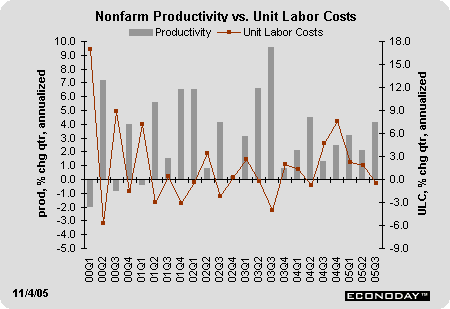
THE ISM SURVEYS
The ISM manufacturing survey was relatively healthy, but many of the components, including the purchasing managers' index, dipped slightly in October from September. But more importantly, the September-October levels in the manufacturing survey are generally higher than those seen in the previous six months. Coupled with the improved payroll and workweek from the employment situation in October, the data suggest that manufacturing activity could be bustling in the final quarter of the year.
The ISM non-manufacturing survey was mostly stronger in October than in September. The business activity index (which is actually akin to the ISM manufacturing production index) jumped several points in October. New orders rose, the supplier delivery index rose as did the backlog of orders. The prices index fell back to (a still high) 78 from 81.4 in September. The employment index dipped 2 points also, although it remained above the 50 percent mark. This survey appears to be in marked contrast to the employment report which showed anemic payroll growth in the service sector.
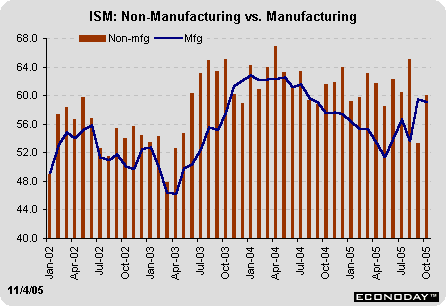
MOTOR VEHICLE SALES PLUNGE IN OCTOBER
Given July's surge, we should not have been surprised with October's plunge. After all, incentives are more likely to change the pattern of sales than introduce many new buyers into the market. But the plunge in sales is significantly more than we saw after similar periods. It is also interesting to see the sharp reduction in the number of light truck sales. Consumers are indeed feeling the pinch on higher gas prices. And it really doesn't matter that gas prices aren't that much higher in real (inflation-adjusted) terms. When you have to pay $100 to fill up your tank instead of $50, it's a shock to the system.
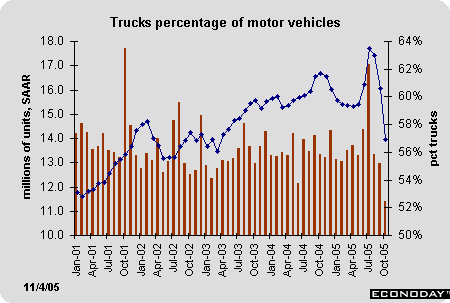
Looking at a 6-month moving average of motor vehicle sales shows a slightly different picture than this dramatic chart. From January to June 2005, before incentives, domestic motor vehicle sales were running at a 13.5 million-unit rate. In August, this jumped to a 14.2 million-unit rate. In October, with the plunge in sales, the 6-month average selling pace was at a 13.7 million-unit rate. This suggests that automakers might have added a few extra vehicle sales with the incentives. If motor vehicle sales run back up to a 12 million-unit rate in November, from the 11.4 million-unit rate in October, we would get back to the 13.5 million unit rate of the first six months of the year. If sales are much higher than a 12 million-unit rate in November, it could be viewed as a good rebound. If sales are lower than a 12 million-unit rate in November, it would be worrisome for the economy because it would imply that consumers are holding back on spending.
Another interesting point is whether or not consumers will shift spending away from light trucks and towards cars. Car prices tend to be lower than truck prices. My husband and I have recently noticed a greater number of station wagons on the road. I believe that station wagons are counted as cars, not light trucks.
The Bottom Line
The employment report was clearly weaker than many expected - and in fact suggested more weakness in the economy than Alan Greenspan indicated when he testified before the Joint Economic Committee on Thursday. According to the Bureau of Labor Statistics, the October weakness came from the rest of the country - as opposed to hurricane-ravaged areas. But the average workweek was higher in September and October than in the previous several months. This generally bodes well for future employment gains.
Strong consumer spending in the fourth quarter is not a slam-dunk. While chain store sales were decent, they were not robust. Motor vehicle sales were miserable in October, but this could be a payback for incentive-induced sales during the summer. But this bears watching.
While many bond market pundits worried about inflationary wage pressures due to a 0.5 percent spurt in average hourly earnings, we urge caution on this interpretation. The employment mix and the wage patterns within the areas of job growth skew the earnings number. And in any case, this is one of those numbers that needs to be viewed in the context of a 3-month average. The 3-month average was similar to the trend.
Oh, by the way, the FOMC met on November 1 and raised the federal funds rate target by 25 basis points. Oddly enough, the Fed rate action was totally expected, and the post-meeting statement didn't offer any suggestions that policy would change. In the past few months, the Fed's monetary policy has not caused major havoc in the financial markets, though a rising rate environment is clearly not friendly for the equity market or the bond market. But at least consumers with savings will see a small increase in their interest earnings.
Looking Ahead: Week of November 7 to November 11
Monday
Consumer installment credit increased $4.9 billion in August, moderating from the pace of the two previous months. Given the slowdown in motor vehicle sales, it wouldn't be a surprise to see continued moderation in September consumer credit usage either.
Consumer credit Consensus Forecast for Sept 05: $6 billion
Range: $-2.5 to $8.0 billion
Thursday
New jobless claims fell 8,000 in the week ended October 29 to 323,000. Fewer and fewer claims are related to hurricanes Katrina and Rita each week, although a few were related to Wilma this week. While new claims are not accelerating anymore, continuing claims remain at very high levels: it will take more than a few weeks for hurricane victims to find new jobs.
Jobless Claims Consensus Forecast for 11/5/05: 320,000 (-3,000)
Range: 305,000 to 353,000
The international trade deficit on goods and services widened in August to $59 billion after narrowing in July. Exports increased 1.7 percent in August, but imports increased 1.8 percent during the month. September figures will reflect Katrina damage to the Port of New Orleans.
International trade balance Consensus Forecast for Sept 05: $-62 billion
Range: $-56 to $-64 billion
Import prices jumped 2.3 percent in September after rising 1.2 percent in each of the three previous months. Oil import prices surged 7.3 percent in September after equally large gains in the three previous months. Crude oil prices were down in October and this could dampen prices.
Import prices Consensus Forecast for Oct 05: 0.0 percent
Range: -0.5 to 0.9 percent
In October, the University of Michigan's consumer sentiment index dropped nearly 3 percentage points to reach 74.2, contributing to the downward trend of the past few months. October auto sales were miserable and that could be an indication that consumers were not any more optimistic in early November than in October.
Consumer sentiment Consensus Forecast for mid-Nov 05: 76
Range: 75 to 78
The U.S. Treasury will release the monthly budget report for October which begins fiscal year 2006. Over the past 10 years, the average deficit amounted to $36 billion during this month. In the past couple of years, however, monthly deficits have been larger than average.
Treasury budget Consensus Forecast for Oct 05: $-55 billion
Range: $-48 to $-82 billion




